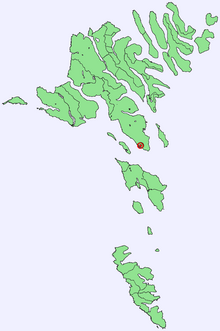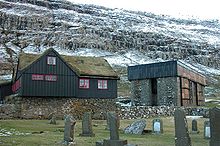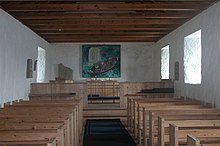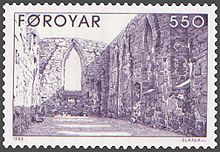Kirkjubøur

Kirkjubøur [ ˈtʃɪʃʊˌbøːʊr ] ( Danish name : Kirkebø , literally: church hall or church village ) is a place in the Faroe Islands in the southwest of the island of Streymoy and, with three important monuments, is one of the country's main attractions.
By the end of 2004, Kirkjubøur formed its own municipality with the neighboring town of Velbastaður . Together the two places had 226 inhabitants (end of 2002). Since January 1, 2005 they belong to the capital municipality of Tórshavn .
In 2015 Kirkjubøur had 80 inhabitants. The zip code is FO-175.
geography
Kirkjubøur is located near the Faroese capital Tórshavn on the southwest coast of Streymoy. Upstream is the two-hectare, uninhabited Kirkjubøhólmur, one of the eleven spars of the Faroe Islands . In the past this small island was connected to the mainland and formed the outer end of a small bay (Brandansvík). However, the connecting strip in between was torn away and washed away during a severe storm in the 17th century. From Kirkjubøur you can also enjoy a view of the offshore islands of Koltur and Hestur .
Directly behind Kirkjubøur rises the southernmost mountain of Streymoy with its two peaks, the 306 meter high Kirkjubøkambur with Sverre's Cave ( Sverrihola ) in the south and Kirkjubøreyn further north at 351 meters. A hiking trail leads between the two to Argir . Another hiking trail to the capital leads west and north along the foot of Kirkjubøreyn. The relatively flat terrain between Tórshavn and Kirkjubøur makes the place ideal for a bike trip on the otherwise very mountainous islands.
The cape at the southern tip of Streymoy is also named after the town of Kirkjubønes.
history
Kirkjubøur was once the spiritual and cultural center of the Faroe Islands. From 1111 (older sources say around 1100 or 1120 at the latest) it was the seat of the diocese of Faroe Islands . Initially subordinated to the Archdiocese of Hamburg-Bremen and Lund , it belonged to the Archdiocese of Nidaros from 1152/1153 . Up until the Reformation on the Faroe Islands in 1538 , 34 bishops resided here. See also List of Bishops of the Faroe Islands .
Sverre Sigurdsson grew up here and attended the Latin school of the diocese before moving to Norway in 1176, where he became the greatest medieval king in his country.
This is also where the legendary Gæsa lived , who lost her extensive holdings of land to the church after eating meat during Lent, which was considered sacrilege. According to legend, she went to Gásadalur , which was named after her.
The most famous bishop in Kirkjubøur was Erlendur († 1308). He had the Magnus Cathedral built, but this led to an uproar among the Faroese because they no longer wanted to pay the high church taxes. Erlendur was overthrown (he was probably able to escape, other traditions say he was killed in Magnus Cathedral). A good hundred years later, another bishop in Kirkjubøur, Johannes Theutonicus, attempted to have Erlendur canonized.
After the Reformation in 1538, Jens Gregersen Riber was a Protestant bishop from 1540 , but he had to give up his office in 1557 and went to Stavanger. The Faroe Islands were then downgraded from a diocese to a próstadømi with a provost at the head, which was subordinate to the diocese of Bergen in Norway. The first provost from 1558 to 1566 was Heini Havreki , deputy of both the last Catholic and the last Protestant bishop.
The time when Kirkjubøur had been the center of spiritual power in the Faroe Islands for centuries was coming to an end. The cathedral school was closed and replaced by a Latin school in Tórshavn, which is first mentioned in written sources in 1547. The provost, who replaced the bishop, stayed mainly on Eysturoy , where the provost 's court, the próstagarður , was also in Oyndarfjørður . The official residence of Løgmaður was moved to the Steigargarður farm in Sandavágur in 1555 by order of the king , which is why Guttormur Andrasson moved from Kirkjubøur to Vágar . The last of the Catholic clergymen were retiring at Sandoy , and the church buildings in Kirkjubøur were now largely in decline.
A good hundred years later, Lucas Debes reported in his book about the Faroe Islands from 1673 that the Olav Church was still in use and the walls of the cathedral were still standing. However, the many stone buildings of the bishopric that once existed there have now been destroyed.
The course of the coastline in Kirkjubøur has also changed significantly over the centuries. Originally, parts of the place were in areas that have now been torn away by the sea and washed away. In the first half of the 17th century, for Candlemas on February 2nd, probably in 1602, during a storm, the banks of Kirkjubøur were severely damaged. The connecting dam between present-day Kirkjubøhólmur and the village was torn away and the previously existing bay ( Brandansvík ) was destroyed. Since then, certain efforts have been made to fortify the bank to prevent further flushing.
In 1772 a severe landslide occurred, which is said to have destroyed the wooden houses. In any case, the north-east corner of the cathedral was badly damaged in this natural event and had to be restored afterwards.
In 1832 the so-called Kirkjubøstein , a stone from the 11th century with 19 runes on it, was found here. This rune stone is around a hundred years older than the Sandavág stone and thus probably the oldest written monument on the Faroe Islands. After the stone was kept in the Danish National Museum for a long time , it is now back in the Faroe Islands.
Well-known people from the village include Løgmaður Pætur Jákupsson and the poet and long-time politician Jóannes Patursson (1866-1946), who together with his brother Sverre Patursson became the driving force behind the modern Faroese national-cultural movement.
The famous artist Tróndur Patursson also lives in Kirkjubøur .
heritage Site
Kirkjubøur is best known for:
- the ruins of Magnus Cathedral from around 1300
- the neighboring Olavskirche ( Ólavskirkjan ) from the 13th century
- the oldest preserved farm in the Faroe Islands from the Viking Age, the royal court of Kirkjubøur (Kirkjubøargarður).
- the remains of a church building in the direction of Kirkjubønes, now known as "Líkhús". It is believed to be the remains of the ecclesiastical building mentioned in a document written by Bishop John Theutonicus in 1420 and which was dedicated to the Irish navigator saint Brendan . Its veneration was widespread at that time, especially among Hanseatic merchants and seafarers, who also financially supported the church building activities in Kirkjubøur. The bank area immediately in front of the remains is still called Brandansvík today. According to other sources, according to a legend, it was a Lady Chapel, which is associated with the legendary woman named Gæsa .
In this place already settled the Irish monks in the 7th century , and the site is on the candidate list for UNESCO World Heritage Site .
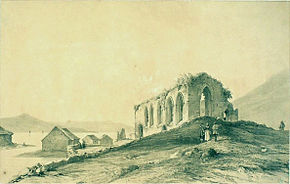
The ruins of the cathedral are called Mururin (the wall) in the Faroe Islands . As "Magnusdom" under Bishop Erlendur, it was supposed to be the largest sacred building in the Faroe Islands, but it was never completed and therefore has neither windows, nor a roof, nor a tower. However, recent studies indicate that the cathedral was once in use and was only demolished after the Reformation to such an extent that only the stone walls that are visible today remain.
A rune stone, the Kirkjubø stone, was found near the cathedral in 1832 .
Right next to it is the Wikingerhof, another architectural monument. The Catholic bishops once resided here, and the Faroe Islands' first school was located here. Today it has been expanded into a museum and is the seat of the influential Patursson family .
In addition to the cathedral ruins and the Viking Court, there is the somewhat smaller St. Olav's Church, which is also one of the main attractions of the Faroe Islands. Kirkjubøur's stool cheek carvings are from the 15th century and are one of the Faroe Islands' most valuable cultural heritage sites. They were part of the Olav Church, but can now be seen in the History Museum of the Faroe Islands. Olav's Church is not only the oldest church in the Faroe Islands, it is also the only church from the Middle Ages that is still in use there today.
festival
In 2009 a rock festival will take place here for the first time. It is called Við Múrin ("by the wall") after the ruins of the cathedral .
Personalities

- Sverre Sigurdsson (1151–1202) - Norwegian king.
- Erlendur (–1308) - Bishop of the Faroe Islands.
- Pætur Jákupsson - Løgmaður of the Faroe Islands from 1588 to 1601.
- Helena Patursson (1864–1916) - publicist and first women's rights activist in the Faroe Islands.
- Jóannes Patursson (1866–1946) - important poet and politician of the Faroe Islands. Legacy of the royal court
- Sverri Patursson (1871-1960) - journalist and environmentalist.
- Tróndur Patursson (* 1944) - the most important glass artist in the Faroe Islands and well-known adventurer.
See also
literature
- Chapter 11: Religion — 1100 to 1538 . In: G. V. C. Young: From the Vikings to the Reformation. A Chronicle of the Faroe Islands up to 1538. Shearwater Press, Isle of Man 1979, p. 59.
Web links
- Kirkjuböur , on page 24 in: Faroe Travel Guide 2016, Visit Faroe Islands (German)
- Kirkjubøur , savn.fo (in English)
- Kirkjubøur . patursson.com. Archived from the original on November 27, 2013. (Website of the Patursson family from Kirkjubøur - in English)
- Garðurin , patursson.fo (in Faroese)
- Church stalls - The third series of stalls in the Olavskirche in Kirkjubøur (With a detailed history in German)
- Faroeislands.dk: Kirkjubøur (in English, info. And photos)
Individual evidence
- ↑ On page 140 in: Hans Jacob Debes : Føroya søga 2. Skattland og len. , Føroya Skúlabókagrunnur, Tórshavn 1995. (archive.org)
- ↑ Map of the former coastline in Kirkjubøur. , tidsskrift.dk
- ↑ a b Rolf Guttesen: New Geographical and Historical Information from Lucas Janz Waghenaer's Faroe-chart . In: Geografisk Tidsskrift . Volume 92, 1992, pp. 22-28 (English)
- ↑ On page 140 in: Hans Jacob Debes: Føroya søga 2. Skattland og len. , Føroya Skúlabókagrunnur, Tórshavn 1995.
- ↑ Magnus Cathedral ( Memento of the original from June 29, 2016 in the Internet Archive ) Info: The archive link was inserted automatically and has not yet been checked. Please check the original and archive link according to the instructions and then remove this notice. , savn.fo
- ^ On page 141 in: Hans Jacob Debes : Føroya søga 2. Skattland og len. , Føroya Skúlabókagrunnur, Tórshavn 1995. (archive.org)
- ^ Breaking the Ice: Conflicts of Heritage in the West Nordic Regions , by Lill Eilertsen, liu.se
- ↑ Símun V. Arge & Natascha Mehler: Adventures far from home: hanseatic trade with the Faroe Islands ( Memento of the original from June 18, 2016 in the Internet Archive ) Info: The archive link was inserted automatically and has not yet been checked. Please check the original and archive link according to the instructions and then remove this notice. , in: Across the Northsea: Later Historical Archeology in Britain and Denmark, c. 1500-2000 AD, histarch.univie.ac.at
- ↑ On page 62 in: From the Vikings to the Reformation. A Chronicle of the Faroe Islands up to 1538 by G. V. C. Young. Isle of Man: Shearwater Press, 1979. (in English)
- ↑ Kirkjuböur , on page 24 in: Faroe Travel Guide 2016, Visit Faroe Islands
- ^ Breaking the Ice: Conflicts of Heritage in the West Nordic Regions , by Lill Eilertsen, liu.se
Coordinates: 61 ° 57 ′ N , 6 ° 48 ′ W

